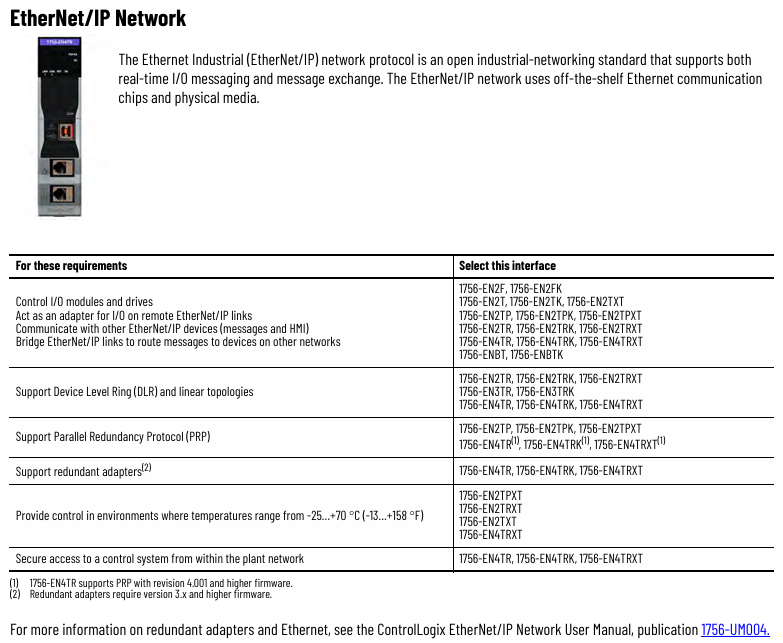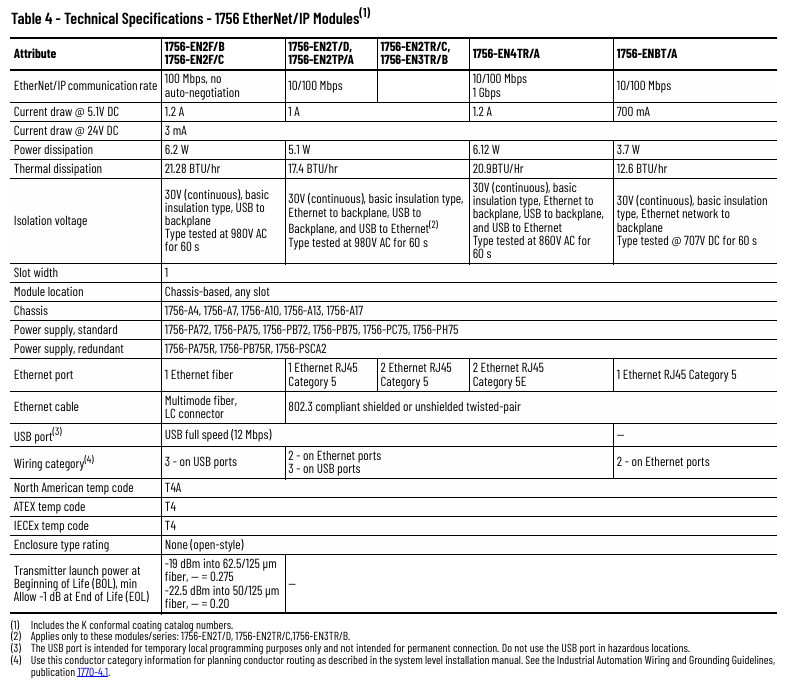Rockwell Automation 1756 ControlLogix Communication Module
Core coverage: 7 types of networks (EtherNet/IP, DeviceNet, DH+, Remote I/O, DH-485, SynchLink, ControlNet), 3 types of special modules (conformal coating, XT wide temperature, legacy obsolete);
Module model system: Named according to "network type+functional characteristics", such as 1756-EN2T (EtherNet/IP network, 2-port), 1756-DNB (DeviceNet network), suffix "K" represents normal coating (anti-corrosion), "XT" represents wide temperature environment (-25~70 ℃).
Rockwell Automation 1756 ControlLogix Communication Module
Basic Information and Module Classification
1. Basic information
Document positioning: Technical manual for industrial grade ControlLogix communication module, including module selection, parameter configuration, installation requirements, suitable for building and maintaining industrial control networks;
Core coverage: 7 types of networks (EtherNet/IP, DeviceNet, DH+, Remote I/O, DH-485, SynchLink, ControlNet), 3 types of special modules (conformal coating, XT wide temperature, legacy obsolete);
Module model system: Named according to "network type+functional characteristics", such as 1756-EN2T (EtherNet/IP network, 2-port), 1756-DNB (DeviceNet network), suffix "K" represents normal coating (anti-corrosion), "XT" represents wide temperature environment (-25~70 ℃).
2. Overview of module classification
Network type, core module model, functional positioning, special version
EtherNet/IP 1756-EN2F/EN2TT/EN2TP/EN2TR/EN3TR/EN4TR/ENBT Industrial Ethernet Bridge, supporting real-time I/O and message communication 1756-EN2TK (coating), 1756-EN2TXT (wide temperature)
DeviceNet 1756-DNB/E connects the underlying network bridging of sensors/actuators-
DH+/Remote I/O 1756-DHRIO, 1756-RIO/B DH+message communication, Remote I/O scanning/adaptation 1756-DHRIOXT (wide temperature)
DH-485 1756-DH485 low-cost serial communication network-
SynchLink 1756-SyncH fiber optic synchronous communication for distributed motion control-
ControlNet 1756-CN2/CN2R/CNB/CNBR legacy control network, real-time high-throughput 1756-CN2RK (coating), 1756-CN2RXT (wide temperature)
Legacy 1756-EWEB (web server) and 1756-TIME (time synchronization) have been discontinued and alternative solutions are provided-

Core network module technical specifications (sorted by network type)
(1) EtherNet/IP module: Industrial Ethernet core
1. Core functions and selection criteria
Key capabilities: Supports CIP protocol (real-time I/O+message communication), DLR ring network (1756-EN2TR/EN3TR/EN4TR), PRP redundancy (1756-EN2TP/EN4TR, firmware 4.001+), CIP Security encryption (1756-EN4TR);
Selection Comparison Table:
Module model, port specifications, maximum number of connections (TCP/CIP), packet rate (PPS), and adaptation scenarios
1756-ENBT 1 × RJ45 (10/100Mbps) 64/128 5000 (I/O)/900 (HMI) basic Ethernet networking
1756-EN2T 1 × RJ45 (10/100Mbps) 128/256 25000 (I/O)/2000 (HMI) Medium scale I/O control
1756-EN4TR 2 × RJ45 (10/100/1000Mbps) 512/1000 (I/O)+528 (message) 50000 (unencrypted)/15000 (encrypted) large redundant network, supporting 256 axis motion
1756-EN2TXT (wide temperature) 1 × RJ45 (10/100Mbps) 128/256 25000 (I/O) Extreme temperature environment (-25~70 ℃)
2. Common technical parameters
Power supply: 5.1V DC (current 0.7~1.2A), partially supporting 24V DC auxiliary power supply;
Environmental adaptability: Operating temperature of 0-60 ℃ (conventional)/-25~70 ℃ (wide temperature), humidity of 5%~95%, non condensing, ESD resistance (contact with 6kV/air 8kV);
Certification: c-UL-us (Class I Div 2), ATEX Zone 2, CE, RCM, compliant with ODVA EtherNet/IP.
(2) DeviceNet module: underlying device networking
Core parameters: 1756-DNB/E supports 125/250/500kbps communication rate, maximum 64 nodes, 24V DC (11-25V) power supply, current 60mA;
Key features: Supports CIP protocol, adapts to sensors/actuators, USB port for temporary configuration (prohibited for use in hazardous environments);
Environment and Certification: Operating temperature range of 0-60 ℃, certified with EtherNet/IP module, compliant with ODVA DeviceNet.
(3) DH+/Remote I/O module: legacy network compatible
1756-DHRIO (dual function)
DH+function: Supports speeds of 57.6/115.2/230.4kbps, with a maximum of 32 message connections;
Remote I/O function: As a scanner, it supports 32 logical racks and 16 block transfer connections;
Parameters: 5.1V DC current 850mA, operating temperature 0~60 ℃ (conventional)/-25~70 ℃ (XT model).
2. 1756-RIO/B (Remote I/O only)
Function: Supports scanner/adapter mode, 32 physical racks, transfers analog/digital/block data;
Restriction: When used as an adapter, it must be paired with a ControlLogix controller.
(4) ControlNet module: Legacy High Throughput Network
Core parameters: Communication rate of 5Mbps, maximum 99 nodes, 1756-CN2/CN2R supports 128 Logix connections, 1756-CNB/CNBR supports 40-48 connections;
Redundancy feature: 1756-CN2R/CNBR supports dual port redundancy to ensure uninterrupted network operation;
Alternative suggestion: It is recommended to migrate to EtherNet/IP, refer to the "ControlNet to EtherNet/IP Migration Reference Manual" (CNET-RM001).
(5) Other network modules
1756 SynchLink: Fiber optic communication (650nm wavelength, 200/230 μ m HCS fiber), speed 5Mbps, high synchronization accuracy, used for multi chassis motion coordination;
1756-DH485 (DH-485): speed of 9.6/19.2kbps, 2 DB9 ports, requires a 1761-NET-AIC converter to connect to the network and adapt to old devices.

Special version and Legacy module description
1. Special version module
Conform coating version (suffix K): such as 1756-EN2TK, 1756-CN2RK, anti salt spray, corrosion, suitable for humid/chemical environments;
- EMERSON
- Honeywell
- CTI
- Rolls-Royce
- General Electric
- Woodward
- Yaskawa
- xYCOM
- Motorola
- Siemens
- Rockwell
- ABB
- B&R
- HIMA
- Construction site
- electricity
- Automobile market
- PLC
- DCS
- Motor drivers
- VSD
- Implications
- cement
- CO2
- CEM
- methane
- Artificial intelligence
- Titanic
- Solar energy
- Hydrogen fuel cell
- Hydrogen and fuel cells
- Hydrogen and oxygen fuel cells
- tyre
- Chemical fiber
- dynamo
- corpuscle
- Pulp and paper
- printing
- fossil
- FANUC
- Food and beverage
- Life science
- Sewage treatment
- Personal care
- electricity
- boats
- infrastructure
- Automobile industry
- metallurgy
- Nuclear power generation
- Geothermal power generation
- Water and wastewater
- Infrastructure construction
- Mine hazard
- steel
- papermaking
- Natural gas industry
- Infrastructure construction
- Power and energy
- Rubber and plastic
- Renewable energy
- pharmacy
- mining
- Plastic industry
- Schneider
- Kongsberg
- NI
- Wind energy
- International petroleum
- International new energy network
- gas
- WATLOW
- ProSoft
- SEW
- wind
- ADVANCED
- Reliance
- YOKOGAWA
- TRICONEX
- FOXBORO
- METSO
- MAN
- Advantest
- ADVANCED
- ALSTOM
- Control Wave
- AB
- AMAT
- STUDER
- KONGSBERG
- MOTOROLA
- DANAHER MOTION
- Bently
- Galil
- EATON
- MOLEX
- Triconex
- DEIF
- B&W
- ZYGO
- Aerotech
- DANFOSS
- KOLLMORGEN
- Beijer
- Endress+Hauser
- MOOG
- KB
- Moxa
- Rexroth
- YAMAHA
- Johnson
- Westinghouse


Email:wang@kongjiangauto.com


































































































































